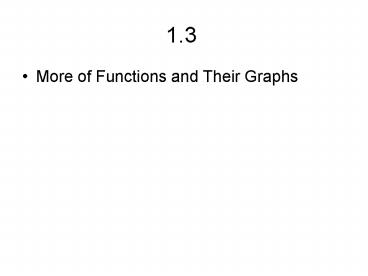More of Functions and Their Graphs - PowerPoint PPT Presentation
1 / 27
Title:
More of Functions and Their Graphs
Description:
Identify intervals on which a function increases, decreases, or is constant. Use ... Useful in discussing the rate of change of function over a period of time ... – PowerPoint PPT presentation
Number of Views:36
Avg rating:3.0/5.0
Title: More of Functions and Their Graphs
1
1.3
- More of Functions and Their Graphs
2
Objectives
- Find simplify a functions difference quotient.
- Understand use piecewise functions.
- Identify intervals on which a function increases,
decreases, or is constant. - Use graphs to locate relative maxima or minima.
- Identify even or odd functions recognize the
symmetries. - Graph step functions.
3
Difference Quotient
- Useful in discussing the rate of change of
function over a period of time - EXTREMELY important in calculus, (h represents
the difference in two x values)
4
Difference Quotients
- Example For the function f given by
- f(x) x2 2x ? 3,
- find the difference quotient
- Solution We first find f(x h)
5
Difference Quotients continued
6
Find the difference quotient
7
What is a piecewise function?
- A function that is defined differently for
different parts of the domain. - Examples You are paid 10/hr for work up to 40
hrs/wk and then time and a half for overtime.
8
A piecewise function is one that is defined in
pieces or intervals of its domain. To evaluate
these type functions be sure to perform any rule
only for values that are in its domain.
9
Functions Defined Piecewise
- Graph the function defined as
- a) We graph f(x) ?3 only for inputs x less than
or equal - to 0.
- b) We graph f(x) ?3 x2 only for inputs x
greater than 0 and less than or equal to 2. - c) We graph f(x)
- only for inputs of x greater than 2.
f(x) ?3, for x ? 0
f(x) ?3 x2, for 0 lt x ? 2
10
Graph the piece-wise functions.
11
Increasing and Decreasing Functions
- Increasing Graph goes up as you move from left
to right. - Decreasing Graph goes down as you move from
left to right. - Constant Graph remains horizontal as you move
from left to right.
12
Definitions
- A function f is said to be increasing on an open
interval I, if for all a and b in that interval, - a lt b implies f(a) lt f(b).
13
Definitions continued
- A function f is said to be decreasing on an open
interval I, if for all a and b in that interval, - a lt b implies f(a) gt f(b).
14
Definitions continued
- A function f is said to be
- constant on an open interval I,
- if for all a and b in that interval, f(a)
f(b).
15
Determine the intervals where the following graph
is (a) increasing (b) decreasing (c) constant
16
Inc (0,2)
y
dec (2,7)
4
(2, 3)
Constant (7,10)
(4, 0)
0
(1, 0)
x
(10, -3)
(0, -3)
(7, -3)
-4
17
Relative Maximum and Minimum Values
- Suppose that f is a function for which f(c)
exists for some c in the domain of f. Then - f(c) is a relative maximum if there exists an
open interval I containing c such that f(c) gt
f(x), for all x in I where x ? c and - f(c) is a relative minimum if there exists an
open interval I containing c such that f(c) lt
f(x), for all x in I where x ? c.
18
These points are recognized as high or low
points on the graph of the function.
19
Relative extrema
Maxima
Minima
20
Use the graph to determine any relative maxima or
minima of the function and give the intervals on
which the function is increasing or decreasing.
maximum
minimum
increasing
decreasing
21
Use the graph to determine any relative maxima o
r minima of the function and give the intervals
on which the function is increasing or decreasing.
maximum
minimum
(3.601, 2.921)
increasing
(0.103, 0.955)
decreasing
22
The following graphs exhibit symmetry.
23
Even Odd Functions
- Even functions are those that are mirrored
through the y-axis. (if x replaces x, the y
value remains the same) (i.e. 1st quadrant
reflects into the 2nd quadrant) - Odd functions are those that are mirrored through
the origin. (if x replaces x, the y value
becomes y) (i.e. 1st quadrant reflects into the
3rd quadrant)
24
Even and Odd Functions
- If the graph of a function f is symmetric with
respect to the y-axis, we say that it is an
even function. That is, for each x in the domain
of f, f(x) f(?x). - If the graph of a function f is symmetric with
respect to the origin, we say that it is an odd
function. That is, for each x in the domain of f,
f(?x) ?f(x).
25
For now it is sufficient to consider a function
even as long as all variable terms have even
exponents and odd if all variable terms have odd
exponents.
26
Example
- Determine whether the function is even, odd, or
neither. - 1.
- We see that h(x) ? h(?x). Thus, h is not even.
- 2.
- We see that h(?x) ? ?h(x). Thus, h is not odd.
27
Problem 61 page 165.

